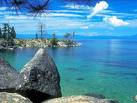PLITVICE Lakes, Croatia - Geographical Location
GEOGRAPHICAL LOCATION AND IMPORTANCE OF THE LAKES IN CROATIAN SPACE
After so many millions of regular visitors of this part of Croatia, is it necessary at all to mention their location? The answer is NO to those who know, and YES to all of those who haven't been there. This large number of visitors from all the continents of our planet
 Earth is just one of the reasons, but also a confirmation of their exceptional beauty, natural attraction, uniqueness and of that something which can be hardly described by words - that remains only recorded in sound and picture or can be directly felt while being there - to support a not imposed wish on us to come back here as soon as we can. One should only let himself to hidden feelings, to complete calmness, to listening to the murmur of waterfalls, while looking at the reflection in the water - in the surrounding where everything moves, changes and is permeated with one harmonious rythm...
Earth is just one of the reasons, but also a confirmation of their exceptional beauty, natural attraction, uniqueness and of that something which can be hardly described by words - that remains only recorded in sound and picture or can be directly felt while being there - to support a not imposed wish on us to come back here as soon as we can. One should only let himself to hidden feelings, to complete calmness, to listening to the murmur of waterfalls, while looking at the reflection in the water - in the surrounding where everything moves, changes and is permeated with one harmonious rythm...Geographically defined: The Lakes are located in the area of southeast Europe, in part of Croatia where we go from northern flat land towards a bit more elevated karsted mountain area. The Lakes are situated where Kordun touches Lika and in the valley Ogulinsko - Plascanska dolina, on the very spring of the karst river Korana - at 480 to 636 meters above the sea level, on the hillside of Mala Kapela and Pljesivica.

The road directions coming from northern side from Varazdin, going through Zagreb and then continuing towards central and southern section of the Adriatic, are bringing us just next to the Plitvice Lakes as well as do the roads coming to them from Kvarner, Gorski Kotar, Slovenia and neighbouring Bosnia and Herzegovina, connecting west with east, or south with north of this part of Croatia. All these directions are connecting tourist attractions of "Primorsko - Adriatic" region with continental area, but visits are varying depending on the season of the year. Respective signs at the border crossings and in all bigger city centres are indicating the location of the Plitvice Lakes and the distance to them. That is why are we always in a position of making decision to go there and stay at the Lakes, either in spring, summer, autumn or winter - taking into account climatic conditions and the time that we have.
. . . . . . . . . . . . . . . . . . . . . . . . . . . . . . . . . . . . . . . . . . . . . . . . . . . .














